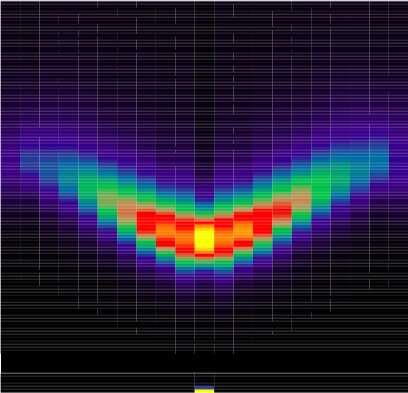A figure that shows the researchers’ main result - the Higgs mode signal in the dynamical structure factor in the setup relevant to the previous neutron scattering experiments. Credit: Ying, Schmidt & Wessel.
Recent polarized inelastric neutron scattering experiments have identified the amplitude (i.e. Higgs) mode in C9H18N2CuBr4, a 2-D, near-quantum-critical spin ladder compound that exhibits a weak easy-axis exchange anisotropy. Inspired by these findings, researchers at RWTH Aachen University, Harbin Institute of Technology and the University of Erlangen-Nürnberg have carried out a study examining the dynamic spin structure factor of planar coupled spin-ladder systems using large-scale quantum Monte Carlo (QMC) simulations.
"The observation and understanding of the Higgs amplitude mode in quantum magnets is exciting, since it connects research in high-energy physics (Nobel prize 2013 for the observation of the Higgs particle) to similar concepts in condensed matter physics," Kai Phillip Schmidt and Stefan Wessel, two of the researchers who carried out the study, told Phys.org via email. "However, this mode is rather fragile in many planar magnets, so its potential experimental detection in a planar quantum magnet of coupled spin ladders by inelastic neutron scattering came as a surprise."
For the purpose of the study, Schmidt developed an approximate theory, which was yet to be rigidly confirmed via quantitative modeling. To achieve this, Wessel, with whom Schmidt was well acquainted, and Tao Ying, a postdoctoral student under Wessel's supervision, decided to try applying Monte Carlo simulations to this problem.
Essentially, they set out to examine the dynamic spin structure factor of previously identified planar coupled spin-ladder systems using QMC simulations. Their combined study, published in Physical Review Letters (PRL), allowed them to achieve a quantitative understanding of the Higgs amplitude mode described in previous research.
"The dynamical structure factor is important, since it contains the full information about the magnetic excitations (like the Higgs amplitude mode) and it is the essential quantity that is measured by inelastic neutron scattering," Schmidt and Wessel said. "Quantum Monte Carlo (QMC) simulations are a very powerful numerical tool to study certain classes of quantum magnets and to extract the dynamical structure factor, which is typically very hard to obtain by other means."
Using state-of-the-art QMC simulation techniques, Schmidt, Wessel and Ying were able to compare the numerical values of certain excitation energies to those measured in inelastic neuron scattering. This subsequently allowed them to pinpoint the magnetic interactions present in a particular quantum magnet.
"The quantitative modeling of the specific experimental quantum magnet and the possibility to interpret the nature of the observed magnetic excitations in theory allows the rigorous identification of the Higgs amplitude mode in a two-dimensional system of coupled spin ladders," Schmidt and Wessel said. "Furthermore, we were able to trace the properties of the Higgs amplitude mode over a large parameters space in our model. This allowed us to follow this particle up to the so-called Ising limit, which is one of the most paradigmatic models in physics."
In their study, Schmidt, Wessel and Ying were able to explicitly understand the Higgs amplitude mode observed in previous experiments as a bound state of two conventional magnetic excitations, which is in analogy to a molecule being made up from atoms. Their work demonstrates the feasibility of formulating a quantitative theory for understanding the spin dynamics of near-quantum-critical 2-D magnets, using state-of-the-art QMC simulation techniques. While they specifically applied their theory to compound C9H18N2CuBr4, they believe that it could also be used to understand the quantum spin dynamics of other similar magnetic compounds.
"There are various interesting routes to follow in the future," Schmidt and Wessel said. "In particular, it will be important to gain an understanding of the fate of the Higgs amplitude mode when it is tuned closer to quantum critical points, e.g. when applying a magnetic field or external pressure, how does this excitation behave and does it become instable?"
More information: T. Ying et al. Higgs Mode of Planar Coupled Spin Ladders and its Observation in C9H18N2CuBr4, Physical Review Letters (2019). DOI: 10.1103/PhysRevLett.122.127201
Tao Hong et al. Higgs amplitude mode in a two-dimensional quantum antiferromagnet near the quantum critical point, Nature Physics (2017). DOI: 10.1038/nphys4182
Journal information: Physical Review Letters , Nature Physics
© 2019 Science X Network
























